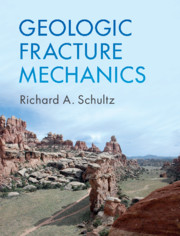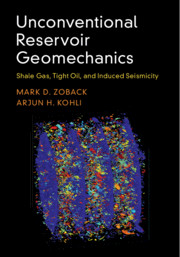Refine listing
Actions for selected content:
1211 results in Ebooks in petroleum sciences
8 - Fracture Mechanics: A Tour of Basic Principles
-
- Book:
- Geologic Fracture Mechanics
- Published online:
- 03 August 2019
- Print publication:
- 08 August 2019, pp 332-399
-
- Chapter
- Export citation
Index
-
- Book:
- An Introduction to Reservoir Simulation Using MATLAB/GNU Octave
- Published online:
- 22 July 2019
- Print publication:
- 08 August 2019, pp 650-657
-
- Chapter
-
- You have access
- Open access
- Export citation

Geologic Fracture Mechanics
-
- Published online:
- 03 August 2019
- Print publication:
- 08 August 2019

An Introduction to Reservoir Simulation Using MATLAB/GNU Octave
- User Guide for the MATLAB Reservoir Simulation Toolbox (MRST)
-
- Published online:
- 22 July 2019
- Print publication:
- 08 August 2019
-
- Book
-
- You have access
- Open access
- Export citation

Unconventional Reservoir Geomechanics
- Shale Gas, Tight Oil, and Induced Seismicity
-
- Published online:
- 14 June 2019
- Print publication:
- 16 May 2019
11 - Geomechanics and Stimulation Optimization
- from Part II - Stimulating Production from Unconventional Reservoirs
-
- Book:
- Unconventional Reservoir Geomechanics
- Published online:
- 14 June 2019
- Print publication:
- 16 May 2019, pp 322-344
-
- Chapter
- Export citation
Contents
-
- Book:
- Unconventional Reservoir Geomechanics
- Published online:
- 14 June 2019
- Print publication:
- 16 May 2019, pp v-viii
-
- Chapter
- Export citation
Part III - Environmental Impacts and Induced Seismicity
-
- Book:
- Unconventional Reservoir Geomechanics
- Published online:
- 14 June 2019
- Print publication:
- 16 May 2019, pp 375-441
-
- Chapter
- Export citation
10 - Induced Shear Slip during Hydraulic Fracturing
- from Part II - Stimulating Production from Unconventional Reservoirs
-
- Book:
- Unconventional Reservoir Geomechanics
- Published online:
- 14 June 2019
- Print publication:
- 16 May 2019, pp 301-321
-
- Chapter
- Export citation
Preface
-
- Book:
- Unconventional Reservoir Geomechanics
- Published online:
- 14 June 2019
- Print publication:
- 16 May 2019, pp ix-x
-
- Chapter
- Export citation
Part I - Physical Properties of Unconventional Reservoirs
-
- Book:
- Unconventional Reservoir Geomechanics
- Published online:
- 14 June 2019
- Print publication:
- 16 May 2019, pp 1-230
-
- Chapter
- Export citation
Index
-
- Book:
- Unconventional Reservoir Geomechanics
- Published online:
- 14 June 2019
- Print publication:
- 16 May 2019, pp 479-484
-
- Chapter
- Export citation
9 - Reservoir Seismology
- from Part II - Stimulating Production from Unconventional Reservoirs
-
- Book:
- Unconventional Reservoir Geomechanics
- Published online:
- 14 June 2019
- Print publication:
- 16 May 2019, pp 263-300
-
- Chapter
- Export citation
6 - Flow and Sorption
- from Part I - Physical Properties of Unconventional Reservoirs
-
- Book:
- Unconventional Reservoir Geomechanics
- Published online:
- 14 June 2019
- Print publication:
- 16 May 2019, pp 149-180
-
- Chapter
- Export citation
13 - Environmental Impacts and Induced Seismicity
- from Part III - Environmental Impacts and Induced Seismicity
-
- Book:
- Unconventional Reservoir Geomechanics
- Published online:
- 14 June 2019
- Print publication:
- 16 May 2019, pp 377-405
-
- Chapter
- Export citation
5 - Pore Networks and Pore Fluids
- from Part I - Physical Properties of Unconventional Reservoirs
-
- Book:
- Unconventional Reservoir Geomechanics
- Published online:
- 14 June 2019
- Print publication:
- 16 May 2019, pp 115-148
-
- Chapter
- Export citation
7 - Stress, Pore Pressure, Fractures and Faults
- from Part I - Physical Properties of Unconventional Reservoirs
-
- Book:
- Unconventional Reservoir Geomechanics
- Published online:
- 14 June 2019
- Print publication:
- 16 May 2019, pp 181-230
-
- Chapter
- Export citation
12 - Production and Depletion
- from Part II - Stimulating Production from Unconventional Reservoirs
-
- Book:
- Unconventional Reservoir Geomechanics
- Published online:
- 14 June 2019
- Print publication:
- 16 May 2019, pp 345-374
-
- Chapter
- Export citation
Copyright page
-
- Book:
- Unconventional Reservoir Geomechanics
- Published online:
- 14 June 2019
- Print publication:
- 16 May 2019, pp iv-iv
-
- Chapter
- Export citation
8 - Horizontal Drilling and Multi-Stage Hydraulic Fracturing
- from Part II - Stimulating Production from Unconventional Reservoirs
-
- Book:
- Unconventional Reservoir Geomechanics
- Published online:
- 14 June 2019
- Print publication:
- 16 May 2019, pp 233-262
-
- Chapter
- Export citation
